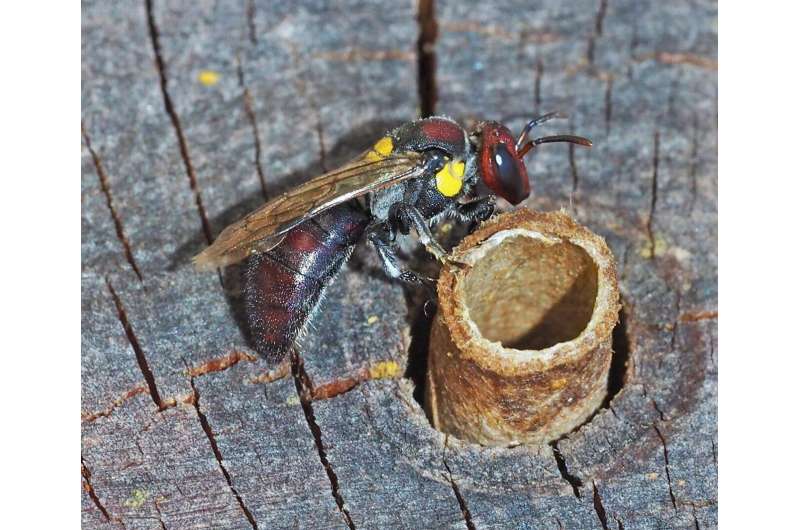Study finds the best plants and bee hotels for boosting urban bee numbers

The presence of more native Australian flowering plants in urban areas can help boost declining bee numbers, with new Curtin University research finding them to be the preferred source of food for both native bees and the introduced European honeybee.
The study focused on 14 sites across the Perth metropolitan area, including bushland remnants and home gardens.
Researcher Dr. Kit Prendergast from the Curtin School of Molecular and Life Sciences, said the study found Australian and introduced bees preferred to visit and feed from native flowers and plants rather than exotic species, with the former particularly reliant on native flora.
“With wild bees facing a global decline, largely due to habitat loss through urbanization, it is vital to understand their preferences. Although urban areas often have a diversity of flowers compared to natural habitats, many of these flowers are exotic species,” Dr. Prendergast said.
The research also helps homeowners, landscapers, landcare communities and councils with a “top ten” species to plant.
“By meticulously recording thousands of interactions between bees and flowers, I identified the top ten flowers that attracted the highest abundance and diversity of native bees. All of these were native flora, primarily from the Myrtaceae family (including eucalypts, bottlebrushes and melaleucas) and Fabaceae (native pea plants). Remarkably these top ten plants were visited by 70 to 80% of all native bees observed during the study.
“The research shows how important native flowers are in supporting native bee and even honeybee populations in urban areas. It also highlights the need for sustainable management of honeybee numbers, as high honeybee populations can deprive native bees of their preferred resources.”
In other new research, Dr. Prendergast investigated the effectiveness of ‘bee hotels’ as nesting habitats for various native bee species in urbanized areas. These purpose-built structures, when combined with an abundance of native flora nearby, proved instrumental in bolstering bee populations.
Dr. Prendergast said although bee hotels have been used for bee conservation for some time, their impact has rarely been assessed. Furthermore, many commercially available bee hotels lack proper design informed by research.
“Based on extensive research of existing literature, I took matters into my hands, designing and installing 120 wooden bee hotels across the 14 study sites in Perth. Each hotel featured nesting holes ranging from 4 to 10mm in diameter,” Dr. Prendergast said.
“Across two years, the data showed that native bees preferred the smaller diameter holes over the larger holes. and my bee hotels attracted 24 different bee species, which is a much greater variety than any Australian study.”
“Bee hotels in bushland remnants were more likely to be occupied than those in gardens, indicating that native bee populations were more abundant in this natural habitat. Surprisingly, greater flower diversity reduced bee hotel occupancy, likely due to the specialized diets of most native bees. On the other hand, a higher proportion of native flowers near bee hotels enhanced bee reproductive success.”
“Together, these studies provide an evidence-based approach for boosting native bee numbers and understanding their ecology. By protecting bushland, identifying and planting the native flowers our indigenous bees prefer, and installing well-designed bee hotels, we can effectively conserve our native bees and ensure their crucial role as pollinators.”
Published in Pacific Conservation Biology and Urban Ecosystems, the research papers are titled “Native flora receive more visits than exotics from bees, especially native bees, in an urbanised biodiversity hotspot” and “Checking in at bee hotels: trap-nesting occupancy and fitness of cavity-nesting bees in an urbanised biodiversity hotspot.”
More information:
Kit S. Prendergast, Native flora receive more visits than exotics from bees, especially native bees, in an urbanised biodiversity hotspot, Pacific Conservation Biology (2023). DOI: 10.1071/PC22033
Kit S. Prendergast, Checking in at bee hotels: trap-nesting occupancy and fitness of cavity-nesting bees in an urbanised biodiversity hotspot, Urban Ecosystems (2023). DOI: 10.1007/s11252-023-01381-5
Citation:
Study finds the best plants and bee hotels for boosting urban bee numbers (2023, June 9)
retrieved 9 June 2023
from https://phys.org/news/2023-06-bee-hotels-boosting-urban.html
This document is subject to copyright. Apart from any fair dealing for the purpose of private study or research, no
part may be reproduced without the written permission. The content is provided for information purposes only.
For all the latest Science News Click Here
For the latest news and updates, follow us on Google News.

